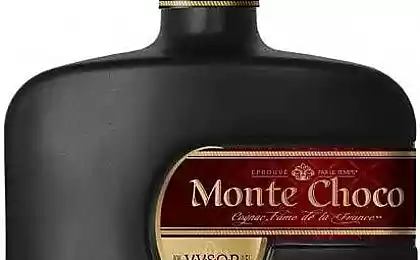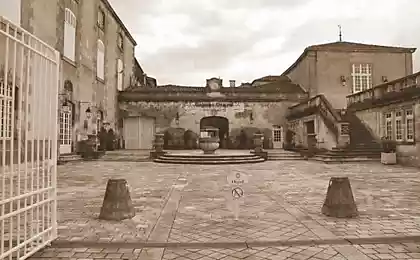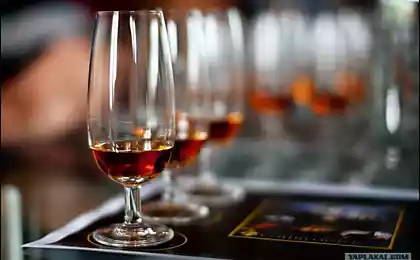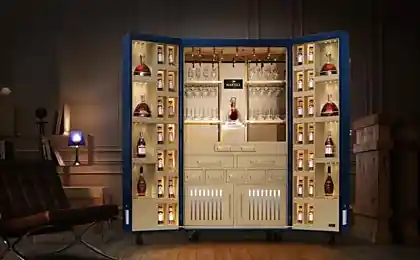665
The birth of cognac
Writes blogger Sergey Anashkevich:
Cognac ... French Dictionary «Petit Larousse» calls it "living water." The birth of brandy - a complex process that lasts for years and decades. In the words of Jean-Paul Camus: "Produce beautiful cognac easily. All you need to do - great-grandfather, grandfather and father, who devoted his entire life »...
Today's story is of a cool, damp and smelling of oak cellar with hundreds of carefully stacked barrels maturing golden drink ...
27 photos

This report was made in the south of Crimea, at the foot of Castel. There, in 1871, the estate of a retired professor of the St. Petersburg Medical-Surgical Academy EA Golubev was founded winery, vineyards laid European varieties and cut tunnels for aging wine in barrels.
Today it is a modern brandy and wine factory "maglev", specializing in the production of brandies and grappa.
The material was prepared with the assistance of the Ministry of Resorts and Tourism of Crimea.

3. We call it the cognac. The same is stated on the label, but the right to say "Brandy" if not drink produced in the vicinity of Cognac in France. Who is writing the name of the drink is allowed "cognac" in Latin letters and in our countries of brandy and still be called cognac ...
The main white grape variety from which the cognac is Ugni Blanc - slowly maturing variety with high acidity, high yield and resistance to disease - botrytis and phylloxera. Also Ugni Blanc, sometimes grown and used in the production of cognac varieties Folle Blanche, Colombard and Montilla. They give a fragrant and rich in taste alcohols than Ugni Blanc, but it is very difficult to grow. Harvest farms usually occurs in October.

4. The collected grapes are exposed to pressing in conventional flat horizontal presses. The resulting juice is left to ferment without the addition of sugar. After three weeks, young dry wine already Blanc de Blanc (about 8% alcohol) is sent to distillation (Charentais method, which reached us unchanged), where it passes two stages of boiling, as a result of which there is cognac alcohol.

5. Brandy alcohol produced in the Charentais alembic, consisting of heated over an open fire of the extraction of the boiler, the boiler cap and a curved tube, which is then transformed into a coil passing through the cooler.
The company "Maglev" uses the classic copper stills of the Swiss company «Arnold Holstein», which gives up to 50 hours gave an ethyl alcohol each. During the period of distillation (from December 1 to April 1), plant distillation of the plant to 100 thousand. Gave cognac.
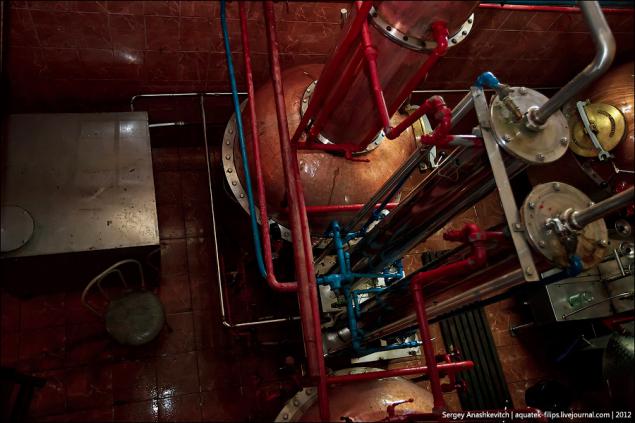
6. Since 1 April (which is allowed in the past, but the report was led by this date), brandy spirit aged in oak barrels (from 270 to 450 liters) at a constant temperature of 15 °. In these casks it can mature from 2 to 50 years. The natural dampness, where casks are stored, is one of the determining factors in the aging process. During this time cognac alcohol loses some of its strength, and the oak gives amber color and pleasant flavors. The substances drawn cognac oak are called dry extracts. Going natural oak qualities develops cognac bouquet, effects the special taste known as rancho.
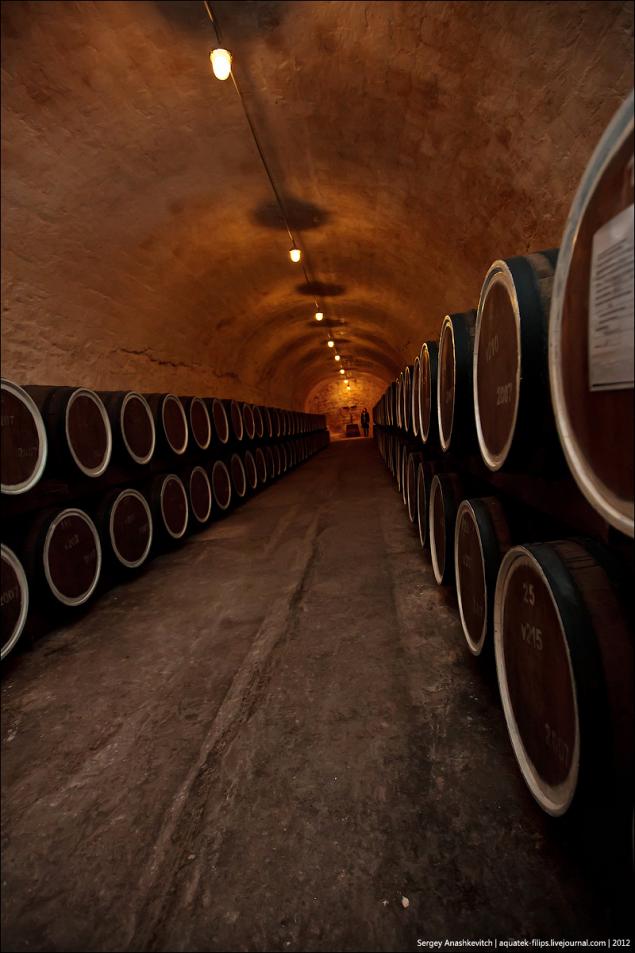
7. maturing cognac in barrels used by the gallery, professor Golubev laid back in the XIX century. They were reconstructed and equipped according to modern requirements and is used for brandy aging in old and new barrels. Now in these galleries are aged over 80 thousand. Future gave the amber beverage.
Against the far wall of the gallery you can see the silent observer - a huge brass corkscrew.

8. That is, leaning on the wooden handle damp basement walls

9. Once the drink goes through all the stages of "miraculous" transformation of the turn of the most important stage - blending of cognacs with different characteristics. The most important role in this process is to create a master florist, or as it is called - the master of the cellar.
In most cases, cognac, as a final product that gets to the consumer, is obtained by assamblirovaniya (or mixing) cognac different years of aging. In this excerpt of the final product is determined by the minimum period of aging components. With mass production of cognac assamblirovanie keeps its organoleptic properties of the same, regardless of the quality of the grape harvest.
And only then carried the latest stage - filling

10. Modern technological bottling lines allow spilling drinks cold-membrane for maximum compliance sterile conditions. First, set the empty bottle on the process belt ...

Source:
Cognac ... French Dictionary «Petit Larousse» calls it "living water." The birth of brandy - a complex process that lasts for years and decades. In the words of Jean-Paul Camus: "Produce beautiful cognac easily. All you need to do - great-grandfather, grandfather and father, who devoted his entire life »...
Today's story is of a cool, damp and smelling of oak cellar with hundreds of carefully stacked barrels maturing golden drink ...
27 photos

This report was made in the south of Crimea, at the foot of Castel. There, in 1871, the estate of a retired professor of the St. Petersburg Medical-Surgical Academy EA Golubev was founded winery, vineyards laid European varieties and cut tunnels for aging wine in barrels.
Today it is a modern brandy and wine factory "maglev", specializing in the production of brandies and grappa.
The material was prepared with the assistance of the Ministry of Resorts and Tourism of Crimea.

3. We call it the cognac. The same is stated on the label, but the right to say "Brandy" if not drink produced in the vicinity of Cognac in France. Who is writing the name of the drink is allowed "cognac" in Latin letters and in our countries of brandy and still be called cognac ...
The main white grape variety from which the cognac is Ugni Blanc - slowly maturing variety with high acidity, high yield and resistance to disease - botrytis and phylloxera. Also Ugni Blanc, sometimes grown and used in the production of cognac varieties Folle Blanche, Colombard and Montilla. They give a fragrant and rich in taste alcohols than Ugni Blanc, but it is very difficult to grow. Harvest farms usually occurs in October.

4. The collected grapes are exposed to pressing in conventional flat horizontal presses. The resulting juice is left to ferment without the addition of sugar. After three weeks, young dry wine already Blanc de Blanc (about 8% alcohol) is sent to distillation (Charentais method, which reached us unchanged), where it passes two stages of boiling, as a result of which there is cognac alcohol.

5. Brandy alcohol produced in the Charentais alembic, consisting of heated over an open fire of the extraction of the boiler, the boiler cap and a curved tube, which is then transformed into a coil passing through the cooler.
The company "Maglev" uses the classic copper stills of the Swiss company «Arnold Holstein», which gives up to 50 hours gave an ethyl alcohol each. During the period of distillation (from December 1 to April 1), plant distillation of the plant to 100 thousand. Gave cognac.

6. Since 1 April (which is allowed in the past, but the report was led by this date), brandy spirit aged in oak barrels (from 270 to 450 liters) at a constant temperature of 15 °. In these casks it can mature from 2 to 50 years. The natural dampness, where casks are stored, is one of the determining factors in the aging process. During this time cognac alcohol loses some of its strength, and the oak gives amber color and pleasant flavors. The substances drawn cognac oak are called dry extracts. Going natural oak qualities develops cognac bouquet, effects the special taste known as rancho.

7. maturing cognac in barrels used by the gallery, professor Golubev laid back in the XIX century. They were reconstructed and equipped according to modern requirements and is used for brandy aging in old and new barrels. Now in these galleries are aged over 80 thousand. Future gave the amber beverage.
Against the far wall of the gallery you can see the silent observer - a huge brass corkscrew.

8. That is, leaning on the wooden handle damp basement walls

9. Once the drink goes through all the stages of "miraculous" transformation of the turn of the most important stage - blending of cognacs with different characteristics. The most important role in this process is to create a master florist, or as it is called - the master of the cellar.
In most cases, cognac, as a final product that gets to the consumer, is obtained by assamblirovaniya (or mixing) cognac different years of aging. In this excerpt of the final product is determined by the minimum period of aging components. With mass production of cognac assamblirovanie keeps its organoleptic properties of the same, regardless of the quality of the grape harvest.
And only then carried the latest stage - filling

10. Modern technological bottling lines allow spilling drinks cold-membrane for maximum compliance sterile conditions. First, set the empty bottle on the process belt ...

Source:










